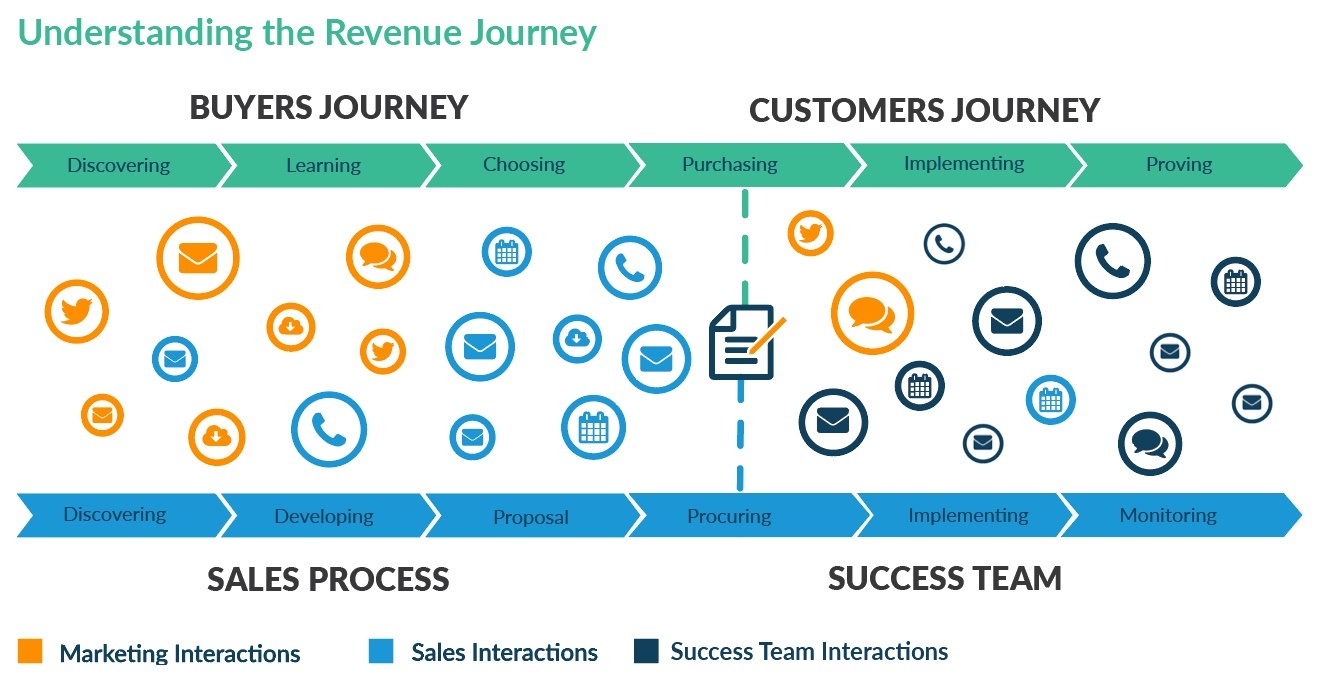 Most B2B Sales organizations concentrate on their Sales Process without mapping the process to how their buyers buy.
Most B2B Sales organizations concentrate on their Sales Process without mapping the process to how their buyers buy.
Yet, how the Sales Process aligns—or doesn’t—to the Buyers Journey is essential to understanding the logistics, timing and needs involved in winning deals. This combined process of the Buyers Journey and Sales Process is called the Revenue Journey.Sales and Marketing alignment is an ever-present goal, but how well are tactics and discussions centered around buyers?
Understanding the Revenue Journey
To outperform competitors and impress buyers, sales organizations need to reach beyond instinct and individual experience. Instead, sales—ideally, with marketing—should visually map out the way your buyers buy and how that aligns to your organization’s activities. The below chart outlines a simple Revenue Journey that helps you build buyer awareness into your process. Notice how the interactions by Marketing, Sales and Success teams can overlap timing wise.
[Click image to view larger]
Understanding how your Sales Process aligns to your buyers helps to bring context to process. Thinking about the Buyer Stage “Learning” as an example; there may be multiple buyers on the prospect side involved at that stage, all with their own needs and preferences. The Sales rep has a process to follow in “Developing” which may include a requirement for prospecting calls, emails and outreach. A sales process requirement out of context of buyer needs may cause friction with the buyer. If the buyer prefers to see a case study before scheduling a meeting, reaching by phone and email 15 times without sending the case study will likely be fruitless and exhaust or annoy the buyer. Helping the rep understand the mindset and needs of the buyers in “Learning” will help them to develop communication styles and tactics that are more likely to engage buyers.
Sales can use this context and insight to more effectively advance prospects from one stage to the next. An action list sales can follow to move deals forward includes:
- Know your buyers. Sales reps can be more efficient and effective with their time by focusing on engaging contacts that map to the key buyer personas. With 5 or more buyers in the average buying committee, and even more influencers in the overall buying group, it’s more important than ever to help sales understand who to strategically speak to and when.
- Track buyer progress. Capturing data on the ways your buying committee is interacting with sales activities, marketing campaigns and with your brand in general can yield powerful insights about deal timing, alignment of buyers to their own process and potential talking points or sales strategies. Understanding these interactions empowers alignment between sales and marketing, and most importantly, alignment of both groups to buyers.
- Address buyer needs. Having a deep understanding of buyer needs and strategies planned out for how to meet those needs will help sales reps be able to address buyer needs more rapidly, and more effectively at that.
- Prevent friction. Aligning with marketing on how and when to best interact with buyers in an account is critical. There’s nothing more frustrating to a sales rep tirelessly working to execute a sales process and move their deal forward than an ill-placed marketing send that they perceive to be irrelevant to their buyer. After all, they’ve worked hard to get the buyer interested, and any interaction that doesn’t support their plan is likely seen by the rep as hostile (and vice versa when marketing sees sales taking measures to control campaign reach). With both teams aligning their campaigns and processes to the buyer, buyers have a better experience and friction between the two sides of your revenue team can be eliminated.
Framing your processes and strategies around your buyers and the Revenue Journey sets the stage for more strategic planning and frictionless buyer experience.


